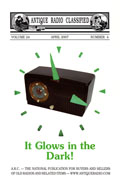Of Old Radios And Related Items--Published Monthly
VOLUME 24 APRIL 2007 NUMBER 4
EDITOR'S COMMENTS
From Antique Radio Classified for April 2007
(Copyright 1996-2007 by John V. Terrey - For personal use only.)Radio and clocks have become such a team (like the horse and carriage of a familiar song) that it's hard to remember when the union became an integral part of our lives. This thought came to mind as we changed our clocks to daylight savings a month earlier than usual.
Somehow, this schedule change made us more aware of how complex the once simple task of resetting clocks has become. Now we find that when setting the clocks on computers, as well as the clocks on appliances, including clock radios, the process is different for each one. Even resetting a watch can be a challenge.
That's why it's a pleasure sometimes to be able just to move the hands on a grandfather clock or turn the knobs on a simple alarm clock. But, clocks, like radio, have evolved, from decorative to utilitarian, from relatively simple to more complex operations, so the union of the two was a natural course of events.
It was inevitable that radio would become an almost universally used "alarm clock," and Steve Auyer describes one of the examples -- a 1950 GE Model 64. This is a nice, simple clock radio, but Steve uses it to illustrate a feature that we can't imagine living without -- glow-in-the dark dials. However, few of us may know that, in these early sets, the source of the illumination was radium-containing paint.
The link between clocks and radio is also illustrated by Richard Arnold's article tracing the history of the Sonora Company. This company evolved from a manufacturer of clocks in the early 1900s, to a manufacturer of windup phonographs, and, eventually, of radios and vacuum tubes.
A Model WAU-243 table set first piqued Richard's interest, but he then followed the company's history through changing products, international connections, two bankruptcies, and its demise in 1958. It's interesting that the company motto "Clear as a Bell" prevailed no matter what the product, clock or radio.
Restoring a set to its original condition, just as it came from the store, is another way of pursuing radio history. Don Watson achieved this goal in restoring the cabinet, as well as the chassis, of his Sears Silvertone 8052. However, he has had a little more trouble with the history of his set -- the year of manufacture is in question. As always, we hope Steve gets some input from readers.
Ray Chase continues to give us more valuable input on what's going on out there in the auction world. This time he covers three smaller auctions, which together totaled less than $40,000. Though there were no highly collectible items, over four dozen microphones selling from $3 to $350, highlighted the Dale Putt auction of the Robert Wilson collection.
In the Parzow auction of the Lee Kemp collection, radios were a small percentage of a general auction and were disposed of in about 20 minutes. Four items -- two Atwater Kent breadboards, and two Federals, a 61 and a 110 -- accounted for $2,800 of the total of about $5,000.
The September Estes auction is described as an old-fashioned, clean-out kind of sale. Only one item, an Atwater Kent breadboard, sold for over $1,000, and only 47 items, for over $100. Ray emphasizes that these were not "soft" prices, but that they simply reflect the fact that many of the items were left over and had not been included in previous auctions due to space or time.
This auction also illustrated the doggedness of collectors when on the auction circuit. To an outsider, Ray's description of the auction weather conditions would have made giving the whole thing up an easy choice. Not so for the radio collectors -- they hung in there despite the rain and cold.
A.R.C. Benefits. Be sure to take advantage of A.R.C. benefits: a toll-free number (866) 371-0512; Discover, MasterCard, American Express, Visa accepted; the Web, www.antiqueradio.com; books shipped free in the U. S. by USPS media mail; and for current subscribers, a 10 percent discount on all book orders.
Coming Radio Events. Spring in the air prompts collectors to begin to emerge from hibernation and get to more events. Among the choices this month are 24 meetings, 15 meets, and 5 auctions. Be sure to get out and enjoy at least one of each.
Happy Collecting!
John V. Terrey, Editor
ON THE COVEROn the cover is a photo of Steve Auyer's GE Model 64 table radio, an example of the subject of his lead article "Glow-in-the-Dark Radios." Superimposed on the radio is an enlargement of the radio's glowing dial.
| [Free Sample] [Books, etc., For Sale] [Subscribe to A.R.C./Renew] [Classified Ads] [Auction Prices] [Event Calendar] [Links] [Home] [Issue Archives] [Book Reviews] [Subscription Information] [A.R.C. FAQ] URL = http://www.antiqueradio.com/edcom04-07.html Copyright © 1996-2007 by John V. Terrey - For personal use only. Last revised: March 30, 2007. For Customer Assistance please contact ARC@antiqueradio.com or call (866) 371-0512 Pages designed/maintained by Wayward Fluffy Publications
Antique Radio Classified |
